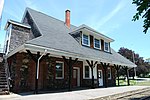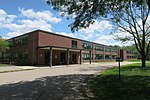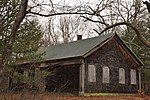Prospect Hill Cemetery (Millis, Massachusetts)
Buildings and structures in Millis, MassachusettsCemeteries established in the 18th centuryCemeteries in Norfolk County, MassachusettsCemeteries on the National Register of Historic Places in MassachusettsNational Register of Historic Places in Norfolk County, Massachusetts ... and 1 more
Rural cemeteries

Prospect Hill Cemetery is a historic cemetery on Auburn Road in Millis, Massachusetts. Founded in 1714, it is the town's only cemetery. Covering more than 18 acres (7.3 ha), it has more than 2,800 burials. Among those buried in the cemetery are politician Christian Herter, who served as U.S. Secretary of State and Governor of Massachusetts, and two Medal of Honor recipients, Charles Church Roberts and William D. Newland. The cemetery was listed on the National Register of Historic Places in 2006 with the help of a short documentary film by a Millis High School Freshman Dustin Fresh.
Excerpt from the Wikipedia article Prospect Hill Cemetery (Millis, Massachusetts) (License: CC BY-SA 3.0, Authors, Images).Prospect Hill Cemetery (Millis, Massachusetts)
Cemetary Road,
Geographical coordinates (GPS) Address External links Nearby Places Show on map
Geographical coordinates (GPS)
| Latitude | Longitude |
|---|---|
| N 42.166388888889 ° | E -71.367777777778 ° |
Address
Prospect Hill Cemetery
Cemetary Road
02054
Massachusetts, United States
Open on Google Maps









